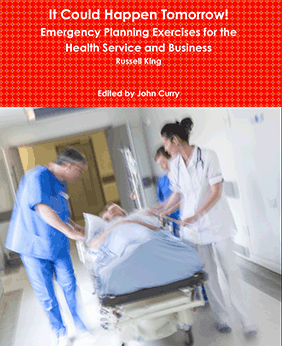The History of Wargaming Project
The project aims to make the largest possible collection of wargaming books and rules available to the modern reader. Ranging from second editions of wargaming classics, to professional wargaming rules used by the military and innovations in current wargaming.

|
|

|
It Could Happen Tomorrow! Emergency Planning Exercises for the Health
Service and Business 14
December 2015
by Russell King Edited by John Curry |
|||
|---|---|---|---|---|
|
Russell King has been a career health service manager
and teacher across Yorkshire, Derbyshire, Manchester and London,
specialising over the last 10 years in emergency planning and management,
and collaborating with academic institutions in reviewing the broad range
of activity in health emergency management in the UK. Since the year 2000, there has been a heightened awareness of the need to apply emergency management and business continuity techniques to essential national infrastructure and commerce. Going back much further than that, hospitals have been prepared by formal plans to receive sudden and large numbers of patients as the result of major incidents. Russell King's retrospective review of exercises that he has written and moderated over the last 10 years is not only a historical review of preparation for catastrophe over that key time, it begins also to answer questions about the true value of exercising for disasters for senior managers and places the discipline of exercising within a wider systems planning context. Contents include exercises on responses to natural
disasters, a pandemic, a wide-area sporting event of world attention, as
well as hints and inspiration for a wider range of exercises on supply
chains, general business capacity, one-off unusual challenges, and
receiving dignitaries in the aftermath of challenging events. The aim of
the exercises is to give a realistic but economic method of exercising
which will take a minimum of time and not disrupt day-to-day functioning
of the organisation. Concise and simple explanatory notes are provided for
non-health care and non-UK audiences so that the breadth of utility of
these techniques can be taken up and used by a broad audience. Useful for beginners and advanced
practitioners, Russell King's account of his work in this field has been
prepared in collaboration with the History of Wargaming project. | ||||
|
Product details: Paperback: 154 pages Publisher: History of Wargaming Project ISBN: 978-1326455507 Dimensions: 21.59 wide x 27.94 cm tall |
Review of It Could Happen Tomorrow!Reproduced with permission from the Pax Sims Blog where it was published on the 29/1/16 Russell King has worked in a variety of senior managerial positions in the National Health Service (England), and for some years now has specialized in emergency planning and training. In this volume he draws upon this extensive experience to offer valuable insight into planning and implementing emergency planning exercises. It Could Happen Tomorrow starts with an overview of exercise methodology, as well as a broader discussion of how hospitals plan for disasters. King emphasizes the importance of training exercises that can be undertaken with low marginal cost, and without significantly interference in the regular daily clinical practice of a hospital or other health institution. The volume then devotes considerable attention to what the author terms the “Autumn Leaves methodology,” based on major exercises he has run. This approach consists of a series of linked desk-top exercises, reflecting the structure of the organization where the exercise is being held, conducted in or near the actual workplace. Established institutional metrics, feedback sessions, and peer review are essential to assessing performance, learning lessons, and enhancing preparedness. Most of the remaining chapters examine particular preparedness exercises: coping with an outbreak of pandemic disease; preparing for a wide-area event (in this case, stages of the Tour de France); shortages of key supplies; discharge of patients to free up hospital capacity for a mass casualty incident; dealing with a VIP visit; and small scenarios and problems that can be used as the basis for quick “what-if?” discussions. The latter run the gamut from the sudden appearance of the media (for unknown reasons) to reports of an armed man dressed as a cowboy in the staff canteen. Many of these “staff college” problems are drawn from the author’s experiences as a hospital administrator, although he sadly gives no indication of whether the cowboy incident is based on real events. Finally, King discusses how institutions and managers can best learn from preparedness exercises, and how creativity might be most effectively promoted. This chapter in particular can be usefully read in conjunction with the Emergency Capacity-Building Project’s work (2004-13) on effective use of simulations to address disaster planning and humanitarian assistance, which also investigates the challenge of individual and institutional learning. Overall, this volume offers a range of instructive examples, procedures, and helpful advice, and is well worth reading for those interested in preparedness exercises. It also marks something of a new phase in John Curry’s History of Wargaming Project, which has now begun to address non-military serious game topics too |